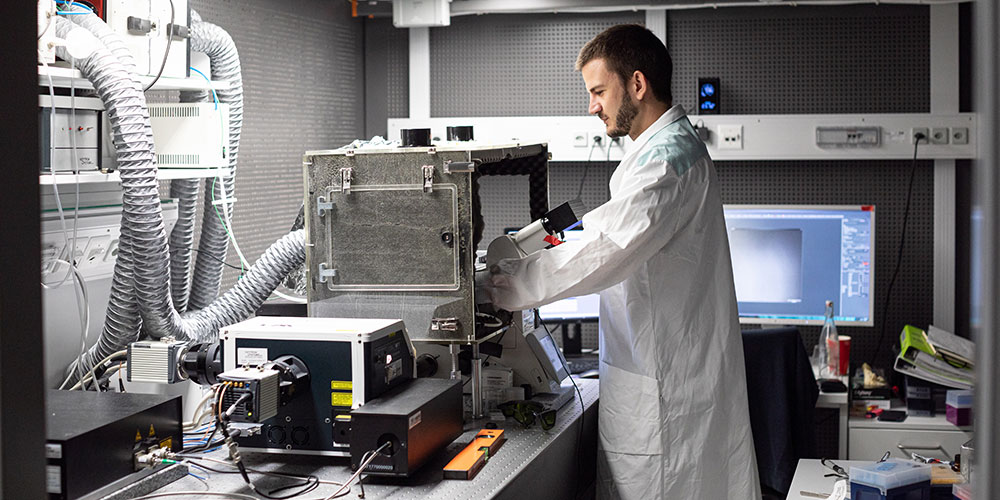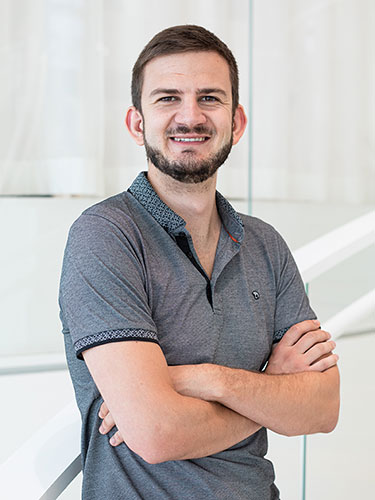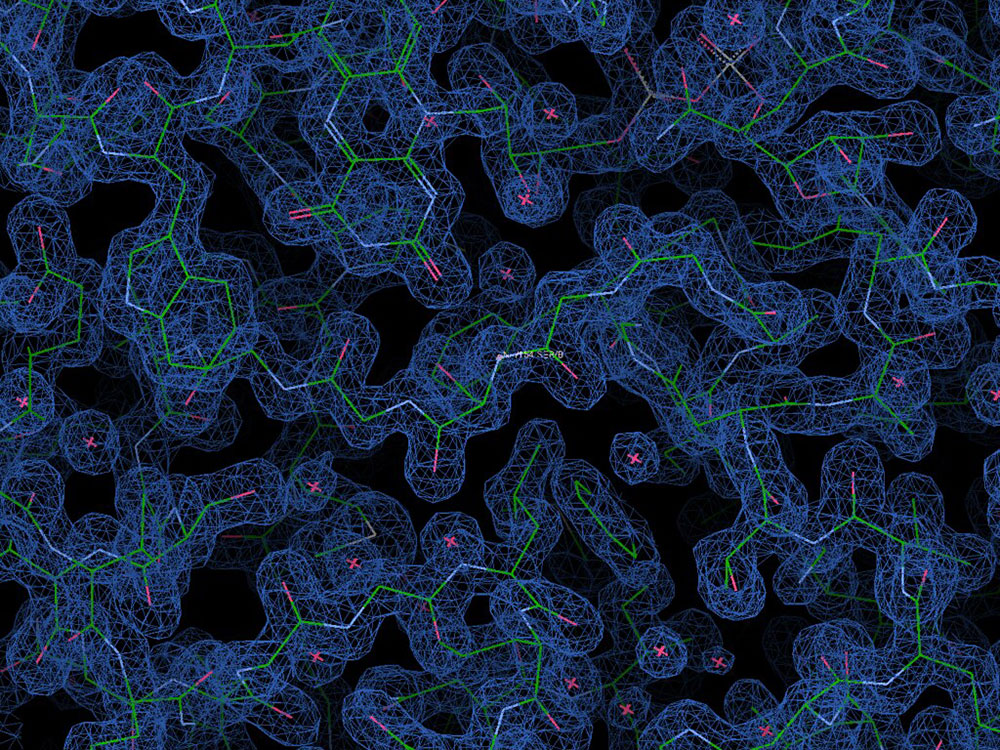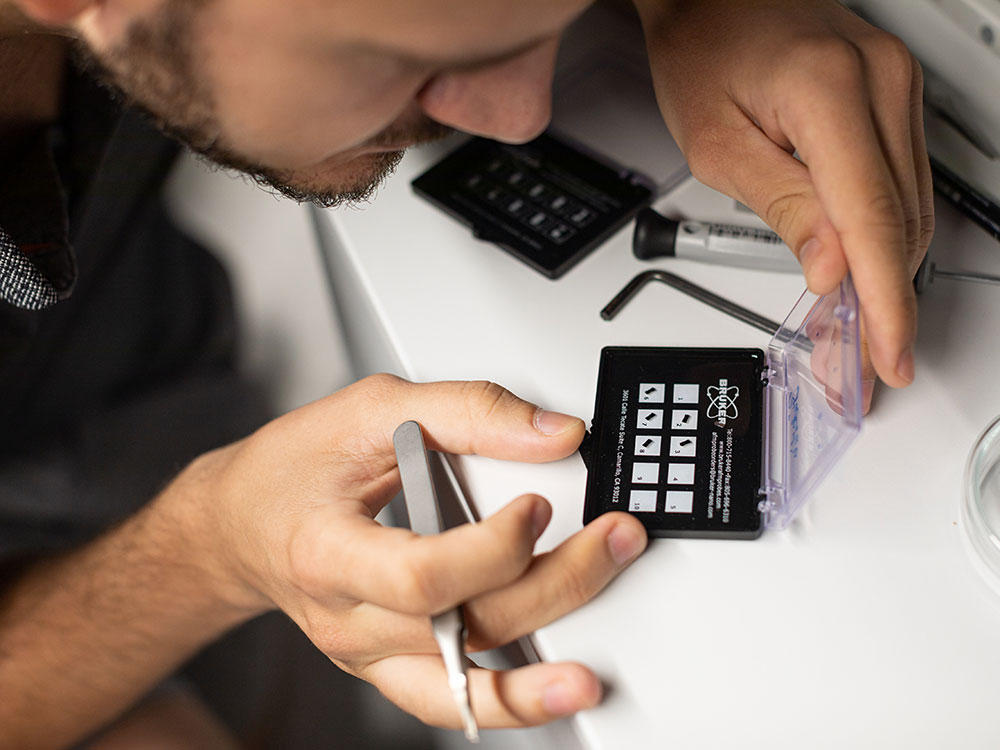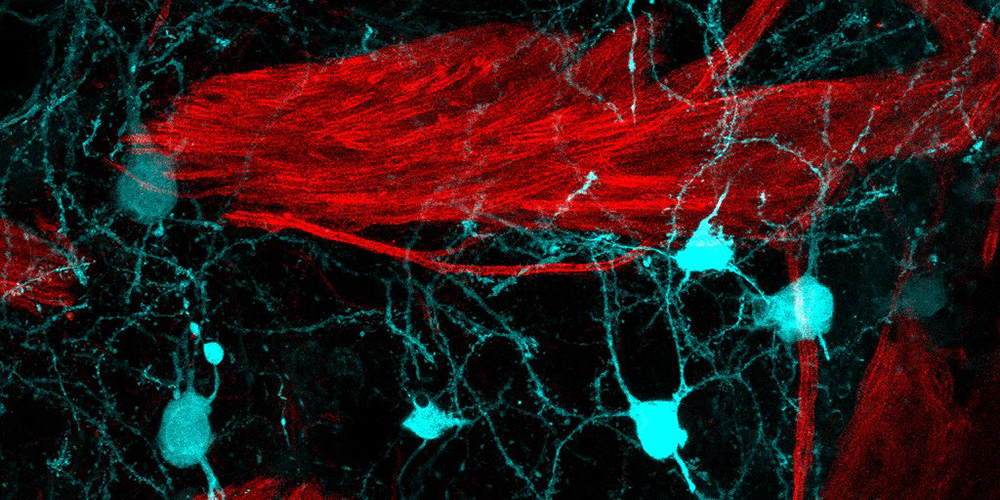In Focus: Mitchell Brüderlin Is Sounding the Attack on Bacteria
You can’t see Mitchell Brüderlin’s work – at least, not with the naked eye. The nanoscientist’s research on bacteria sits at the intersection of biology and physics. When he’s not losing track of time in the basement of the Biozentrum, he can look out from his office over the city where his scientific career began.
26 July 2022
How did Mitchell Brüderlin end up on the third basement floor of the Biozentrum, tinkering with a laser? It all started with an orange. When he was in high school, the first lecture he heard on nanoscience used the fruit in a size comparison. “The ratio between an orange and Planet Earth is the same as that between an orange and an atom,” his teacher said. Brüderlin was fascinated. A few years later, he decided to study nanoscience in Basel.
He had originally planned to go in a different direction. Brüderlin, who attended high school in Muttenz, chose economics and law as his major. He wanted to become a lawyer. His father was an accountant, his mother worked in real estate. A law degree would have fit right in.
Going for an interdisciplinary degree
That stayed hypothetical. Brüderlin was more drawn to the natural sciences than to his major. “We had an amazing biology teacher who got us all crazy excited for the subject,” he relates. His mathematics teacher also kindled his love of the natural sciences. It was these two teachers who brought Brüderlin to the nanoscience lecture with the orange. They told him about a program for gifted students he could take advantage of to attend individual lectures at the University of Basel while he was still in high school.
Brüderlin, who grew up in Möhlin and Rheinfelden, chose to study nanoscience because he couldn’t choose. “I loved it all: biology, chemistry, physics, mathematics – I wanted to know more about everything.” In nanoscience, he studied biology with biologists and chemistry with chemists. “I could be part of everything. It was perfect.”
He wanted to go abroad and stayed in Basel
He knew early on that he wanted to study the very small. “Whole organisms didn’t interest me. I’ve always loved the nitty-gritty details.” That’s obvious when you listen to Brüderlin explain the technologies that make atoms visible. We can’t see them directly, but computers can generate an image: “The idea that an X-ray hits an atom, and we can calculate the electron density from the deflection of the beam is incredible,” he says with a huge grin on his face.
The bachelor’s degree in nanosciences was followed by a master’s and now a dissertation – all in Basel. Brüderlin already knew he would take this path when he began his studies. “May as well go all in,” he says with a laugh. “I actually wanted to do my dissertation abroad or at least at a different university. But it just so happened that the most exciting project was at the Biozentrum,” says Brüderlin.
Brüderlin’s work connects two of the Biozentrum’s focal areas
He is now working in a research group in which professors Roderick Lim (focus on exchange of RNA and proteins inside and outside the cell nucleus) and Marek Basler (focus on the type 6 secretion system – the molecular mechanism that looks like a harpoon) have joined forces. Brüderlin was drawn to interdisciplinarity once more.
He commutes between the 10th floor, the 5th floor and the 3rd basement floor of the new Biozentrum for his research on the nano-harpoon of Pseudomonas aeruginosa. This bacterium, which is known for causing infections in hospitals and plays a role in cystic fibrosis and pneumonia, attacks neighboring cells with a shot similar to that of a harpoon.
How does life work at the microscopic scale?
When two of these bacteria are close to each other, they have a gunfight. “They start shooting at each other like battleships,” Brüderlin says, his eyes sparkling. The goal of his basic research is to understand the logic behind these attacks.
The 26-year-old is visibly enthused by his work and his dissertation topic, “A death-dealing nanomachine.” “For me, this is the epitome of nanoscience,” he says. “It’s asking the core question of biology: how does life work? And it’s studying it in the molecular realm. Everything I loved about my degree, now I can continue that in this project.” While Brüderlin sits at a desk and talks, he gestures with his hands, sweeping from left to right over the table, tracing expansive figures, only to indicate between his thumbs the unimaginably small molecules he is studying.
0.00001 millimeters
“Science is like a big puzzle. You’re always looking for the next little piece that fits,” he says. That’s just his kind of thing: “When I was a kid, I spent hours solving sudokus and doing puzzles.” Brüderlin wants to continue pursuing this passion. He is clear on his career goal: “I want to be a professor.”
Mitchell Brüderlin spends most of his time in the laboratory, where he uses a 0.00001 millimeter needle to prod bacteria under an atomic force microscope. He wears a lab coat and gloves for protection against the bacteria and glasses for when he turns on the laser.
Research, Rhine swimming and discofox
He does see daylight sometimes. “My professor, Roderick Lim, told me I should go to the 5th floor at least once a day to chat with my colleagues.” A good tip, Brüderlin found out. He has a tendency to become absorbed, lose track of time and then spend the whole day without human contact.
But the Fricktal native is anything but antisocial. He was on the student council during his undergraduate degree program. “It let me network with people from multiple years.” Learning curves also brought the students together: “When everyone in the tutorial group looked up from the page and exploded with laughter because nobody understood the assignment, we all felt a bit better,” he remembers.
Brüderlin still enjoys putting together events for his colleagues. He represents the nanosciences doctoral students to the Swiss Nanoscience Institute and organizes events. He is sociable outside work as well. “I absolutely love playing boardgames and Dungeons & Dragons with friends. Spending an evening with non-academics does you good now and then.” Sports are part of the balance. In addition to hiking, skiing and swimming in the Rhine, he has been dancing discofox with a partner for eight years and takes part in competitions.
“The biggest expert is you”
But his biggest passion is science in all its facets. “When the first paper with my name on it was published, that was insanely exciting.” The young researcher also still loves his everyday work after a year and a half: “Your project is your baby. Nobody knows as much about it as you – not even your professor.”
Brüderlin is still at the beginning of his academic career. The nano-harpoons will keep him busy for a while longer. After that, he will have to decide whether his career will take him abroad or whether he will stay in Basel. He isn’t worried about it: “As long as I can do research, I’m happy.”
In Focus: the University of Basel summer series
The In Focus series showcases young researchers who are playing an important role in furthering the university’s international reputation. Over the coming weeks, we will profile seven academics from different fields – a small representative sample of the 3,000+ doctoral students and postdocs at the University of Basel.

